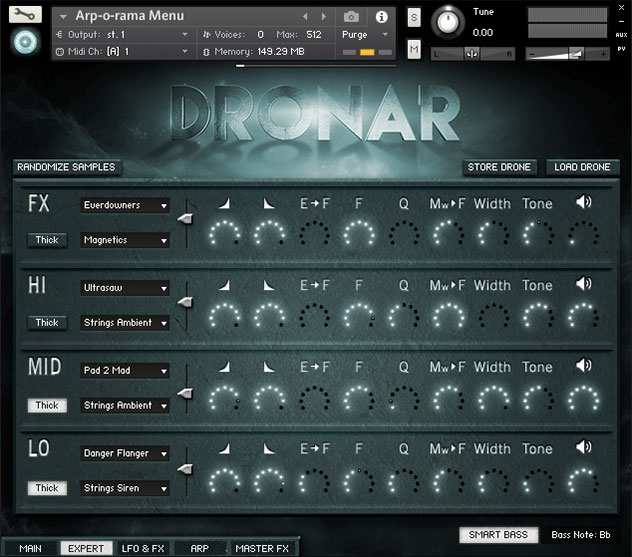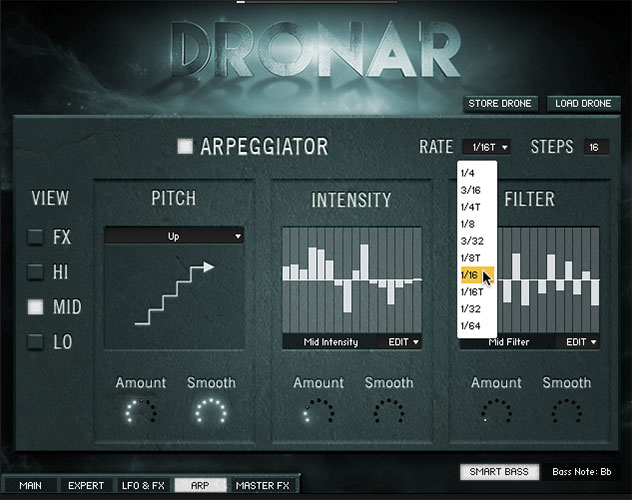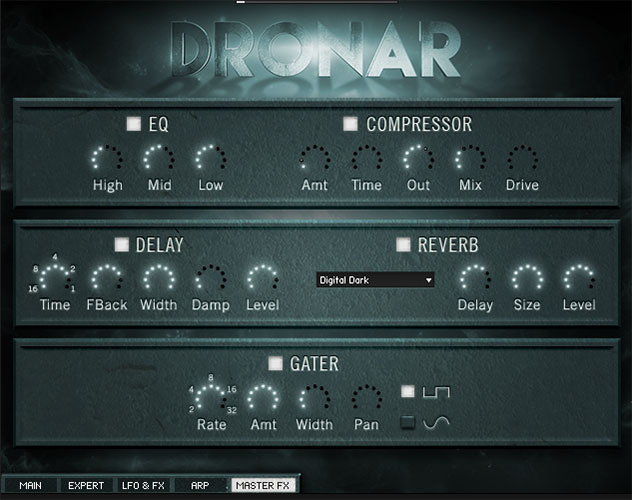- Gothic Instruments' Dronar is a Kontakt 5 sample library with a specific purpose: to provide atmospheres, textures and, of course, drones to your productions. As such, its most immediate target audience will be those working on music-to-picture projects, though it's capable of delivering the goods in a broader range of musical contexts.
The library offers 16GB of sample content but it'll only require 8GB of hard drive space thanks to compression. The main window of the interface gives you a clear insight into Dronar's approach but it requires some clarification. At first glance, three of its four most prominent rotary controls appear to be EQ related, as they're labeled Low, Mid and High. However, Dronar actually works by assigning sounds from its sample libraries to these tiers, so by increasing or decreasing the rotary dial assigned with each layer, you're actually controlling volume. Each of these tiers hosts two sounds, with a further two assigned to the FX slot. This means that each Dronar program provides control over eight layers of sound, which helps explain its sonic richness.
Just as the Low, Mid and High sections host sounds rather than tone-shaping tools, so the FX slot is also somewhat curiously named, as it provides the final two layers of sonic content, albeit those of a more effected, sound design-based nature. You can click on a layer to mute it, or control-click to solo it, which is a useful way to hear each layer in turn, or to remove an unwanted layer from the overall mix. As you might expect, each layer provides content based on its label. For instance, the Low layer provides sub and rumble, the Mid controls depth and warmth and so on. Effectively, this means that the volume dials for each layer are akin to the volume faders on a mixing desk, letting you set balances for what adds up to a full, frequency-rich sound when all four layers are actively engaged.
Preset starting points can be loaded from the browser on the left-hand side, which contains numerous themed patches. But things get more interesting when you take control of the sounds assigned into each of the eight slots yourself. This is done on the Expert page, where different samples are available to both slots in each of the four layers.
 Every layer features its own set of sound-shaping parameters. Firstly, a slider sets the mix balance between the twin sound sources, before each layer can have its Attack and Release times modified. After this comes Filter control, with an Envelope-to-Filter amount dial alongside Cutoff and Resonance controls.
Every layer features its own set of sound-shaping parameters. Firstly, a slider sets the mix balance between the twin sound sources, before each layer can have its Attack and Release times modified. After this comes Filter control, with an Envelope-to-Filter amount dial alongside Cutoff and Resonance controls.
 The Mod Wheel can affect the filter amount per layer too, while Stereo Width and overall Tone and Volume dials complete the set. If you want to roll the dice, you can randomise sample selection instead of assigning sounds from the drop-down lists for each layer.
The next page provides LFO and FX control but to grasp its capabilities, we first need to understand that Dronar contains so-called Drone Keys in its lower octave. If you load one of the Menu patches from the library's starting points, you'll find that these trigger different presets, allowing you to switch between drone treatments in real-time as you play. The LFO and FX page lets you configure settings unique to each drone within a preset, adding LFO movement to Pitch, Tone and Volume. Below this, you can also configure Distortion and Chorus effects.
The Mod Wheel can affect the filter amount per layer too, while Stereo Width and overall Tone and Volume dials complete the set. If you want to roll the dice, you can randomise sample selection instead of assigning sounds from the drop-down lists for each layer.
The next page provides LFO and FX control but to grasp its capabilities, we first need to understand that Dronar contains so-called Drone Keys in its lower octave. If you load one of the Menu patches from the library's starting points, you'll find that these trigger different presets, allowing you to switch between drone treatments in real-time as you play. The LFO and FX page lets you configure settings unique to each drone within a preset, adding LFO movement to Pitch, Tone and Volume. Below this, you can also configure Distortion and Chorus effects.
 Further down are send levels to the onboard Reverb and Delay effects. Remember, all of these settings are available on a per-drone basis, so if you're using all 12 drone layers available within an individual program, that's 12 lots of individual settings you can configure here.
The Arpeggiator comes next, which allows you to add moving and pulsing treatments, with individual arpeggiation routings to Pitch, Intensity and Filter modules.There's an Arp-O-Rama preset which is worth exploring to understand the Arpeggiator's capabilities, but it won't be long before you're adding settings like an expert—this is a nicely configured addition, which takes Dronar's dense, spacious core remit and warps its movement in all kinds of musically-useful ways. This is certainly one feature which will appeal to those making music beyond the music-for-picture arena. Neatly, you can configure individual settings for each layer; just remember to click the layer you wish to edit on the left before proceeding with tweaking settings. The Arpeggiator page's settings can be controlled from one of the other dials back on the Main page. The Movement rotary introduces any configurations you've set up here, progressively introducing arpeggiation into your drone, which makes this movement highly playable.
Further down are send levels to the onboard Reverb and Delay effects. Remember, all of these settings are available on a per-drone basis, so if you're using all 12 drone layers available within an individual program, that's 12 lots of individual settings you can configure here.
The Arpeggiator comes next, which allows you to add moving and pulsing treatments, with individual arpeggiation routings to Pitch, Intensity and Filter modules.There's an Arp-O-Rama preset which is worth exploring to understand the Arpeggiator's capabilities, but it won't be long before you're adding settings like an expert—this is a nicely configured addition, which takes Dronar's dense, spacious core remit and warps its movement in all kinds of musically-useful ways. This is certainly one feature which will appeal to those making music beyond the music-for-picture arena. Neatly, you can configure individual settings for each layer; just remember to click the layer you wish to edit on the left before proceeding with tweaking settings. The Arpeggiator page's settings can be controlled from one of the other dials back on the Main page. The Movement rotary introduces any configurations you've set up here, progressively introducing arpeggiation into your drone, which makes this movement highly playable.
 Lastly, the Master FX page introduces effects which are applicable to an entire Dronar program. These include EQ, Compressor, Delay, Reverb and Gater effects, with appropriate and self-explanatory parameters in each category.
Lastly, the Master FX page introduces effects which are applicable to an entire Dronar program. These include EQ, Compressor, Delay, Reverb and Gater effects, with appropriate and self-explanatory parameters in each category.
 This brings us back to the Main page and an explanation of the Intensity dial. Out of the box, this is mapped to the modulation wheel and it controls the velocity layers of the current program, variously thickening and changing the program to keep Dronar moving, expanding and shimmering in dramatic ways. You can assign Dronar's other dials to MIDI controllers too, or simply draw in variations to the layers with automation.
Dronar is simple to use, sounds excellent and does a pretty good job of providing ways to widen its sonic appeal to a broader range of potential users. That said, it will most readily attract the interest of sound designers and music-for-media composers who will love the sonic complexity and variation afforded by so immediate an interface. For producers making dance and pop music who are looking for deep, rich, evolving sounds, it's also well worth a look.
Ratings:
Sound: 4.3
Cost: 4.8
Versatility: 3.8
Ease of use: 4.6
This brings us back to the Main page and an explanation of the Intensity dial. Out of the box, this is mapped to the modulation wheel and it controls the velocity layers of the current program, variously thickening and changing the program to keep Dronar moving, expanding and shimmering in dramatic ways. You can assign Dronar's other dials to MIDI controllers too, or simply draw in variations to the layers with automation.
Dronar is simple to use, sounds excellent and does a pretty good job of providing ways to widen its sonic appeal to a broader range of potential users. That said, it will most readily attract the interest of sound designers and music-for-media composers who will love the sonic complexity and variation afforded by so immediate an interface. For producers making dance and pop music who are looking for deep, rich, evolving sounds, it's also well worth a look.
Ratings:
Sound: 4.3
Cost: 4.8
Versatility: 3.8
Ease of use: 4.6
 Every layer features its own set of sound-shaping parameters. Firstly, a slider sets the mix balance between the twin sound sources, before each layer can have its Attack and Release times modified. After this comes Filter control, with an Envelope-to-Filter amount dial alongside Cutoff and Resonance controls.
Every layer features its own set of sound-shaping parameters. Firstly, a slider sets the mix balance between the twin sound sources, before each layer can have its Attack and Release times modified. After this comes Filter control, with an Envelope-to-Filter amount dial alongside Cutoff and Resonance controls.
 The Mod Wheel can affect the filter amount per layer too, while Stereo Width and overall Tone and Volume dials complete the set. If you want to roll the dice, you can randomise sample selection instead of assigning sounds from the drop-down lists for each layer.
The next page provides LFO and FX control but to grasp its capabilities, we first need to understand that Dronar contains so-called Drone Keys in its lower octave. If you load one of the Menu patches from the library's starting points, you'll find that these trigger different presets, allowing you to switch between drone treatments in real-time as you play. The LFO and FX page lets you configure settings unique to each drone within a preset, adding LFO movement to Pitch, Tone and Volume. Below this, you can also configure Distortion and Chorus effects.
The Mod Wheel can affect the filter amount per layer too, while Stereo Width and overall Tone and Volume dials complete the set. If you want to roll the dice, you can randomise sample selection instead of assigning sounds from the drop-down lists for each layer.
The next page provides LFO and FX control but to grasp its capabilities, we first need to understand that Dronar contains so-called Drone Keys in its lower octave. If you load one of the Menu patches from the library's starting points, you'll find that these trigger different presets, allowing you to switch between drone treatments in real-time as you play. The LFO and FX page lets you configure settings unique to each drone within a preset, adding LFO movement to Pitch, Tone and Volume. Below this, you can also configure Distortion and Chorus effects.
 Further down are send levels to the onboard Reverb and Delay effects. Remember, all of these settings are available on a per-drone basis, so if you're using all 12 drone layers available within an individual program, that's 12 lots of individual settings you can configure here.
The Arpeggiator comes next, which allows you to add moving and pulsing treatments, with individual arpeggiation routings to Pitch, Intensity and Filter modules.There's an Arp-O-Rama preset which is worth exploring to understand the Arpeggiator's capabilities, but it won't be long before you're adding settings like an expert—this is a nicely configured addition, which takes Dronar's dense, spacious core remit and warps its movement in all kinds of musically-useful ways. This is certainly one feature which will appeal to those making music beyond the music-for-picture arena. Neatly, you can configure individual settings for each layer; just remember to click the layer you wish to edit on the left before proceeding with tweaking settings. The Arpeggiator page's settings can be controlled from one of the other dials back on the Main page. The Movement rotary introduces any configurations you've set up here, progressively introducing arpeggiation into your drone, which makes this movement highly playable.
Further down are send levels to the onboard Reverb and Delay effects. Remember, all of these settings are available on a per-drone basis, so if you're using all 12 drone layers available within an individual program, that's 12 lots of individual settings you can configure here.
The Arpeggiator comes next, which allows you to add moving and pulsing treatments, with individual arpeggiation routings to Pitch, Intensity and Filter modules.There's an Arp-O-Rama preset which is worth exploring to understand the Arpeggiator's capabilities, but it won't be long before you're adding settings like an expert—this is a nicely configured addition, which takes Dronar's dense, spacious core remit and warps its movement in all kinds of musically-useful ways. This is certainly one feature which will appeal to those making music beyond the music-for-picture arena. Neatly, you can configure individual settings for each layer; just remember to click the layer you wish to edit on the left before proceeding with tweaking settings. The Arpeggiator page's settings can be controlled from one of the other dials back on the Main page. The Movement rotary introduces any configurations you've set up here, progressively introducing arpeggiation into your drone, which makes this movement highly playable.
 Lastly, the Master FX page introduces effects which are applicable to an entire Dronar program. These include EQ, Compressor, Delay, Reverb and Gater effects, with appropriate and self-explanatory parameters in each category.
Lastly, the Master FX page introduces effects which are applicable to an entire Dronar program. These include EQ, Compressor, Delay, Reverb and Gater effects, with appropriate and self-explanatory parameters in each category.
 This brings us back to the Main page and an explanation of the Intensity dial. Out of the box, this is mapped to the modulation wheel and it controls the velocity layers of the current program, variously thickening and changing the program to keep Dronar moving, expanding and shimmering in dramatic ways. You can assign Dronar's other dials to MIDI controllers too, or simply draw in variations to the layers with automation.
Dronar is simple to use, sounds excellent and does a pretty good job of providing ways to widen its sonic appeal to a broader range of potential users. That said, it will most readily attract the interest of sound designers and music-for-media composers who will love the sonic complexity and variation afforded by so immediate an interface. For producers making dance and pop music who are looking for deep, rich, evolving sounds, it's also well worth a look.
Ratings:
Sound: 4.3
Cost: 4.8
Versatility: 3.8
Ease of use: 4.6
This brings us back to the Main page and an explanation of the Intensity dial. Out of the box, this is mapped to the modulation wheel and it controls the velocity layers of the current program, variously thickening and changing the program to keep Dronar moving, expanding and shimmering in dramatic ways. You can assign Dronar's other dials to MIDI controllers too, or simply draw in variations to the layers with automation.
Dronar is simple to use, sounds excellent and does a pretty good job of providing ways to widen its sonic appeal to a broader range of potential users. That said, it will most readily attract the interest of sound designers and music-for-media composers who will love the sonic complexity and variation afforded by so immediate an interface. For producers making dance and pop music who are looking for deep, rich, evolving sounds, it's also well worth a look.
Ratings:
Sound: 4.3
Cost: 4.8
Versatility: 3.8
Ease of use: 4.6